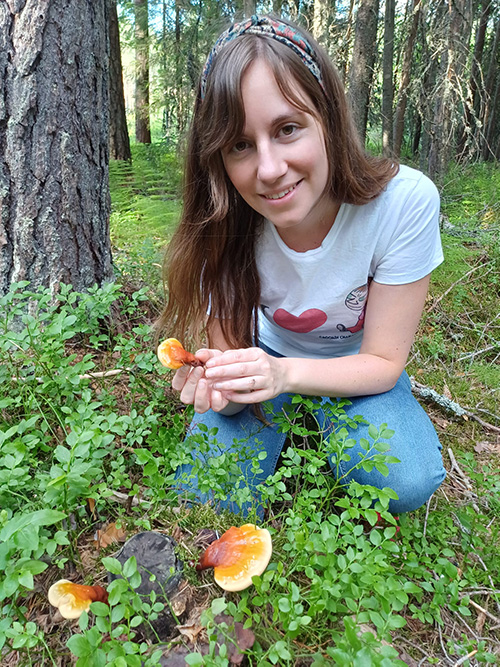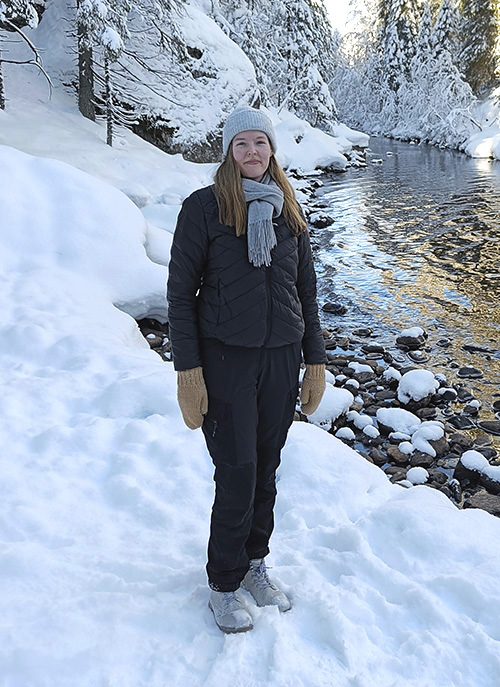Finnish Society of Forest Science awards annually prizes for excellent doctoral and Master’s theses accepted during the preceding year. The awards are made among the theses proposed by the Department of Forest Sciences at the University of Helsinki and the School of Forest Sciences at the University of Eastern Finland. The number of awards is not fixed but depends on the quality of the theses proposed in each year. Typically, the Society awards 1-2 prizes for excellent doctoral dissertations and 1-3 prizes for excellent M.Sc. theses.
The prizes of 2025 were published in the Spring meeting of the Society on 9 April 2025. Dissertation prize awardee gave a talk on her thesis.
Prize for an excellent doctoral dissertation
Dr Marta Cortina Escribano, University of Eastern Finland. Selective breeding and taxonomy of laccate Ganoderma species originating from Finland, https://doi.org/10.14214/df.361
Dr Marta Cortina Escribano studied cultivation techniques of the Ganoderma lucida fungal species complex. The research was conducted with great attention to details from identification of the fungal material studied using DNA analysis to development of the cultivation techniques. The Finnish laccate Ganoderma strains were genetically similar. Thus, the cultivation methods may be assumed to be widely applicable for Finnish Ganoderma strains. Wood side streams were studied as the cultivation media. Especially, aspen and birch wood chips and sawdust are promising cultivation media, based on both mushroom production and chemical composition of the fruiting bodies. The research is scientifically novel and the results are applicable in practical mushroom cultivation. Dr Cortina Escribano had a significantly independent role in the research project and she is the first author of all articles included in the dissertation. The dissertation summary is well-written.
The dissertation was published in the number 361 of Dissertationes Forestales, which is published by the Finnish Society of Forest Science in cooperation with the University of Helsinki and the University of Eastern Finland.
Prizes for excellent M.Sc. theses
M.Sc. Janne Jääskeläinen, University of Helsinki. Mapping forest canopy mortality area using PlanetScope satellite imagery and deep learning, http://hdl.handle.net/10138/589513
Mr Janne Jääskeläinen studied identification of dead trees from PlanetScope satellite images using convolutional neural networks. This satellite imagery covers whole globe almost daily, thus, offering an opportunity for identifying tree mortality in real time. Another benefit in comparison to higher resolution imagery is the cheap access to PlanetScope. The topic is timely and the research problem is important both scientifically and practically. The research is conducted carefully. The introduction gives an extensive overview of the topic based on relevant scientific literature. The methods are described with exceptional details and written in an easy-to-follow style. The discussion shows profound knowledge on the topic. The conclusion is that small dead tree groups are difficult to detect from the used imagery. Considering the careful execution of the research project, the result may be considered real. The thesis is well-written and forms a good basis for a scientific journal article.
M.Sc. Laura Sippola, University of Eastern Finland. Kuusen poiston vaikutus Etelä-Suomen suojeltujen lehtojen kasvillisuuteen, https://erepo.uef.fi/handle/123456789/31852
The topic of the Master’s thesis of Ms Laura Sippola is timely and important. The herb-rich forests play an important role in the maintenance of the biological diversity in the boreal vegetation zone. The research project is very well-conducted. The thesis is written in good Finnish and is easy to follow. The results are analysed and reported with great care. The author analysed field data that she did not collect personally and she could not participate in field decisions. The material is extensive yet partly superficial. The best part of the thesis is the well-written discussion. The author discusses in an excellent manner the materials, methods, the results in relation to earlier research and the importance of the result. The author shows an exceptional maturity in the way she understand the questions that can be answered based on her research and those that remain uncertain and require further study.


